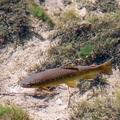Ökologische Verarmung der Flüsse
TUM-Wissenschaftler erfassen Artenschwund durch Querbauten
09.09.2011, Pressemitteilungen
Dämme und Wehre wirken sich stärker auf das Ökosystem von Fließgewässern aus als bisher bekannt. Die Artenvielfalt geht im Staubereich oberhalb der Querbauten stark zurück: Bei Fischen liegt sie durchschnittlich um ein Viertel, bei Kleinlebewesen zum Teil sogar um die Hälfte niedriger. Die Unterbrechung eines Flusslaufes hat damit größere Effekte auf die Tier- und Pflanzenwelt als der geologische Ursprung des Flusses selbst. Das haben Wissenschaftler der Technischen Universität München (TUM) anhand von fünf Flüssen im Einzugsgebiet von Elbe, Rhein/Main und Donau nachgewiesen. Damit liegt erstmals eine Analyse vor, die für beide Seiten der Wehre sowohl abiotische Faktoren wie Chemismus, Strömung und Bodensubstrat, als auch biotische Faktoren wie Anzahl, Größe und Vielfalt aller wichtigen Tier- und Pflanzengruppen erfasst.
Ob zur Stromerzeugung, zur Trinkwassergewinnung oder für den Hochwasserschutz – das Aufstauen ist ein drastischer Einschnitt in das Ökosystem eines Flusses. Denn in ihrer Umgebung verändern Wehre und Dämme die chemischen und physikalischen Eigenschaften des Wassers und des Flussbettes. Damit einher geht ein deutliches Gefälle in der Artenvielfalt zwischen Unter- und Oberwasser, das sich durch wiederholtes Aufstauen verstärkt. Diese sogenannte „serielle Diskontinuität“ haben Systembiologen der TUM zum ersten Mal für alle wichtigen Tier- und Pflanzengruppen gemessen, bisher lagen nur Erkenntnisse zu einzelnen Arten vor. In fünf Flüssen mit unterschiedlichen geologischen Ursprüngen wurden die Wasserlebewesen auf beiden Seiten der Wehre systematisch erfasst. Das Ergebnis: Anzahl, Biomasse und Vielfalt von Aufwuchsalgen, Kleinlebewesen und Fischen sind in Staubereichen stark reduziert. Der gemessene Artenreichtum von Fischen etwa liegt im Vergleich zum Unterwasser durchschnittlich um ein Viertel niedriger, ihre Biomasse verringert sich sogar um den Faktor drei.
Besonders betroffen sind strömungsliebende Fischarten, von denen viele auf der Roten Liste stehen. „Bachforelle, Äsche und Huchen sind anspruchsvolle Fischarten, die sauerstoffreiches Wasser benötigen und in grobkörnigen Kiesbereichen laichen. Als typische Bewohner des Oberlaufs von Flüssen finden sie in aufgestauten Bereichen keinen geeigneten Lebensraum mehr“, erklärt Prof. Jürgen Geist, TUM-Ordinarius für Aquatische Systembiologie. Stattdessen werden diese Abschnitte oft von Brachsen, Döbeln und sogar Karpfen dominiert – Generalisten, die eigentlich an stehende Gewässer angepasst sind. „Besonders dramatisch ist die ökologische Verarmung der Flüsse, wenn aneinandergereihte Staudämme verhindern, dass verschiedene Teillebensräume ausreichend vernetzt sind“, sagt Geist. Allein in Bayerns Flüssen verzeichnet das Bayerische Landesamt für Umwelt mehr als 10.000 Querbauten.
Grund für den Artenschwund ist den Forschern zufolge nicht in erster Linie die Undurchlässigkeit der Barriere für wandernde Fischarten. Vielmehr ist die Veränderung der chemischen und physikalischen Eigenschaften im Fluss ausschlaggebend. Wird die Strömung abgebremst oder unterbrochen, sinkt oberhalb des Wehres die Fließgeschwindigkeit – bei zunehmender Wassertiefe. In allen untersuchten Staubereichen haben die TUM-Wissenschaftler zudem große Unterschiede im Sauerstoffgehalt und in der Temperatur zwischen dem Wasser und dem Sediment im Flussbett gemessen, was die Fortpflanzung strömungsliebender Fischarten erschwert. Hinzu kommen Unterschiede in der Struktur der Sedimente. Unterhalb des Wehres sind die Partikel durchschnittlich doppelt so groß und bieten mehr und hochwertigere Laichplätze.
Flussabschnitte in unmittelbarer Nähe zu Wehren sollten deshalb stärker in ökologische Begutachtungen einbezogen werden, fordert Prof. Geist: „Bei der Beurteilung von neuen Querbauten oder bei der Modernisierung von Wasserkraftwerken geht es nicht nur um die Wanderung einzelner Fischarten, sondern um die Folgen für den Lebensraum Fluss als Ganzes.“ Betroffene Flussbereiche müssten dafür in die relevanten gesetzlichen Regelwerke einbezogen werden, beispielsweise in die Europäische Wasserrahmen-Richtlinie. „Für die Quantifizierung der Auswirkungen von Wehren liegt nun ein Instrumentarium vor, das sowohl die Beschaffenheit des Lebensraumes als auch die Vielfalt der Lebewesen umfasst“, sagt der TUM-Wissenschaftler.
Originalpublikation:
M. Müller, J. Pander, J. Geist: The effects of weirs on structural stream habitat and biological communities, Journal of Applied Ecology (early online)
http://onlinelibrary.wiley.com/doi/10.1111/j.1365-2664.2011.02035.x/abstract
Kontakt:
Prof. Jürgen Geist
Lehrstuhl für Aquatische Systembiologie
Technische Universität München
Telefon:
08161 71 3767 / 08161 71 2173 (Melanie
Müller)
E-Mail: geist@wzw.tum.de
Weitere Informationen:
Jahrestagung der Deutschen Gesellschaft für Limnologie, 12.-16. 9. 2011, Freising-Weihenstephan
http://www.dgl2011.de
Innovatives Kleinwasserkraftwerk: Schachtkraftwerk des TUM-Lehrstuhls für Wasserbau und Wasserwirtschaft
http://portal.mytum.de/pressestelle/pressemitteilungen/news_article.2010-10-19.2049821025
Kontakt: presse@tum.de
Mehr Information
| Biodiversitaet.pdf |
Druckversion dieser Presseinformation,
(Type: application/pdf,
Größe: 71.7 kB)
Datei speichern
|
|
| Effects_of_weirs_on_biodiversity.pdf |
Print version of this article,
(Type: application/pdf,
Größe: 110.6 kB)
Datei speichern
|




